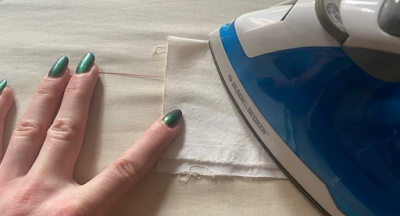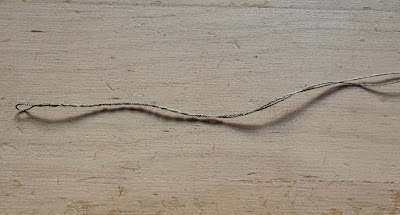You’re happily hand sewing, but your thread keeps getting tangled or frayed or breaking and you’re frustrated. Some of us deal with these issues for years without solution. Fortunately there are ways that you can address thread problems to keep your handsewing enjoyable and fairly stress-free. In this tutorial, and based on tens of thousands of hours and nearly 15 years of experience with hand sewing and embroidery, I am going to explain the main reasons why you’re having thread issues:
1. Friction abrasion
2. Over-twisting and under-twisting
3. Cutting too much thread
4. Choosing the wrong thread
I will explain how to minimize or correct each issue and tell you about some simple tools and techniques that can be helpful whether you’re just starting out or an advanced embroiderer.
Thread Choice Matters
Get a good quality thread for hand sewing and embroidery. Generally, with natural fibers, the smoother the thread feels, the better it is going to perform, the less it will tangle, and the easier it will be to work with. This stems from the manufacturing process itself where individual fibers, or staples, are spun together into thread. A high quality thread catches on your fabric less and suffers less abrasion because the staples are longer.
By comparison, most polyester threads are manufactured by extrusion so that they are one single long fiber, and this has its own drawbacks because low quality polyesters are very prone to breakage along the extruded fibers, which can make them prone to tangling. Many of the common craft store polyester brands that come on spools are made for machine sewing and are troublesome for hand sewing. Think about how your needs (strength, appearance, fiber content) balance with the benefits and drawbacks of different thread options to choose the best candidate for your project.
Beeswax
Beeswax is one of the most important things to have on hand for handsewing because it protects your thread from abrasion, which prevents fraying that can lead to breakage and tangling. It is natural and inexpensive and you can buy it at most sewing supply shops.
The beeswax cake will get cut up over time, but at that stage just put it in the microwave in a silicone cupcake liner to form it back into a good shape. On the next slide, I’ll show you two methods for using beeswax to condition your thread.
Keep it simple: cut your thread length and then drag it across the beeswax cake 2-3 times. If there’s any excess, pull the thread through the pads of your fingers to remove it, because it can get embedded in the surface of your fabric and look crusty. For most types of hand sewing and embroidery, this is enough. By using beeswax, you are slicking down your thread and helping its staples to stick together better, allowing it to glide freely through the fabric. It also stiffens the thread a little, and all of these things help against tangles.
Beeswax: The Ironing Method
By melting beeswax into your thread, you help it penetrate deep into the thread so that it remains permanently. This not only protects the thread while you’re sewing but keeps it smooth and strong for the life of the garment. You should do this when the thread needs extra strength against abrasion, such as when you’re embroidering buttonholes or eyelets. You should also do this with fray-prone linen threads (more on that later). Pre-cut several lengths of thread and drag them across the beeswax until they’re very thoroughly coated. Iron the thread to melt the beeswax into it. I suggest that you sandwich the thread in a press cloth while ironing so that you don’t melt beeswax onto either your iron or ironing table. You don’t want to get beeswax on your other projects.
Correct The Twist
Sometimes when you’re sewing, the thread will start to twist around itself and that causes tangles. The reason this happens is that the thread is formed by twisting fibers together (this is called ply), and as you sew the movement of your hand is either over-twisting or under-twisting the thread from its equilibrium state. The thread naturally tries to correct this by forming extra twists where you probably don’t want them. Using beeswax helps a lot to prevent this problem but it may need some additional help. When your thread starts twisting around itself, move your needle out of the way and pull the thread between the pads of your fingers, starting from where it emerges from the fabric and running all the way to the cut end. Do this until the thread stops twisting around itself.
Don't Cut Too Much
It is always tempting to cut longer and longer pieces of thread so you can tie off/begin new threads less often, but it may be causing more work for you. Longer threads tangle more than shorter threads, and longer threads are also subjected to friction damage over a longer period of time than shorter threads. You may actually have an easier time, and work faster, if you work with shorter lengths of thread. This is especially true with specialty threads like linens or metallics or vintage threads. Overall it’s easier on your working hand as well to work in shorter thread lengths that don’t require such large movements to pull through the cloth.
Linen Thread
Linen thread is a great choice when you want a strong and fairly thick thread, especially if you’re sewing linen fabric or for extra historical accuracy, but it earns special mention because it has an extreme tendency to tangle. Due to its texture it’s also difficult to untangle. I strongly recommend a thorough coat of beeswax, then melting it in to the linen thread with an iron. Also, try using shorter thread lengths, no more than 20” at a time, because abrasion that happens to the thread as you sew makes tangles far more likely.
Metallic ThreadMost metallic threads you see have a fiber core (polyester or silk usually) with flag metal or metallic plastic wrapped around them (lamella). It’s a more fragile type of thread that can be difficult and frustrating to work with. A lot of metallic threads on the market were made for couching or braiding or tatting or other types of crafts, not hand sewing, and cannot stand up to the rigor of being pulled repeatedly through fabric. Of the rest, I’ve found that they can benefit from being waxed before use but it is variable and I suggest doing some test pieces before choosing your final thread and technique and applying it to your final project.









No comments:
Post a Comment